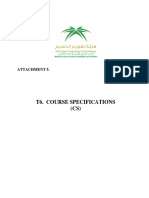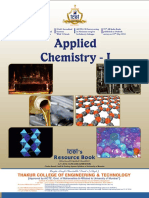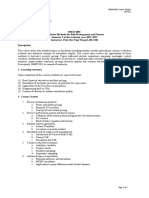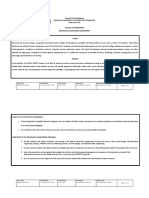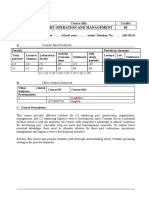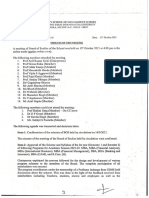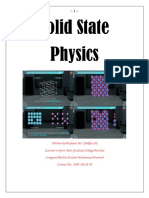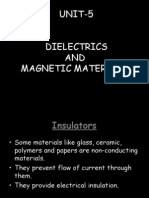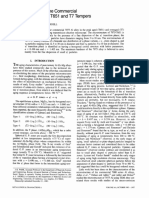SCB23103 Strength of Materials ... Intake Jan 2017
SCB23103 Strength of Materials ... Intake Jan 2017
Uploaded by
johnjabarajCopyright:
Available Formats
SCB23103 Strength of Materials ... Intake Jan 2017
SCB23103 Strength of Materials ... Intake Jan 2017
Uploaded by
johnjabarajOriginal Description:
Original Title
Copyright
Available Formats
Share this document
Did you find this document useful?
Is this content inappropriate?
Copyright:
Available Formats
SCB23103 Strength of Materials ... Intake Jan 2017
SCB23103 Strength of Materials ... Intake Jan 2017
Uploaded by
johnjabarajCopyright:
Available Formats
UNIVERSITI KUALA LUMPUR Rev. No.
: 000
MALAYSIAN SPANISH INSTITUTE Date: 21/03/2016
SECTION OF: Page No: 1 of 6
MECHANICAL COURSE SYLLABUS
Prepared by: Reviewed by:
Name: Mohamad Sabri Mohamad Sidik Name: Mohd Nurhidayat Zahelem
Position: Senior Lecturer/Subject-Matter Expert Position: Programme Coordinator
Approved by:
Name: Mohamad Shukri Mohd Zain
Position: Head Of Section
PROGRAMME ALL BACHELOR’S DEGREE PROGRAMMES
COURSE CODE SCB 23103
COURSE NAME Strength of Materials
Effective Date: January 2017
UNIVERSITI KUALA LUMPUR Rev. No.: 000
MALAYSIAN SPANISH INSTITUTE Date: 21/03/2016
SECTION OF: Page No: 2 of 6
MECHANICAL COURSE SYLLABUS
1 Course Name:
Strength of Materials
2 Course Code:
SCB 23103
3 Course Category ():
Course Course Category
National Requirement
Compulsory Course
University Requirement
Common Core
Discipline Core
Core Course
Elective
Others
4 Academic Staff Name(s):
1. Mohamad Sabri Mohamad Sidik
2. Mohd Nurhidayat Zahelem
3. Prof. Dr. Ishak Abdul Azid
4. Johan Ihsan Mahmood
5. Zainal Nazri Mohd Yusuf
5 Rationale of Inclusion of Course/Module in the Programme:
This course is a preparation for students to understand the both the theory and application of the
fundamental principles of mechanics for materials which are being used widely in engineering fields.
6 Year and Semester Offered:
Year 2, Semester 3
7 Total Student Face to Face Non Face to Face Total of
Learning Time (SLT) L T P O (Non F2F) F2F + Non F2F
(hours):
34 17 5 64 120
8 Credit Value:
3 (2, 1, 0)
9 Prerequisite(s), if applicable:
SCB12103 Engineering Mechanics
10 Course Learning Outcomes:
Upon completion of this subject, students should be able to :
1. Identify the principle of stresses, strain and the mechanical properties of mechanical
materials. (C2, PLO1)
2. Calculate the stresses, strain and the mechanical properties of material in mechanical
applications. (C3, PLO2)
Effective Date: January 2017
UNIVERSITI KUALA LUMPUR Rev. No.: 000
MALAYSIAN SPANISH INSTITUTE Date: 21/03/2016
SECTION OF: Page No: 3 of 6
MECHANICAL COURSE SYLLABUS
3. Analyse the effects of load to materials in engineering applications by using strength of
materials analysis. (C4, PLO2)
4. Calculate the torsional and combined stresses in materials by using Mohr’s circle analysis.
(C4, PLO2)
11 Transferrable Skills:
Skill Skill Development Skill Assessment
Problem Solving Students are required to solve tutorial questions or Quizzes and Written
examples in order to enhance their understanding in Tests
this subject.
Critical Thinking Students are required to think and use their ingenuity Written Tests and
to solve strength of materials problems Final Examination
12 Learning-Teaching and Assessment Strategy:
Teaching-Learning Strategy
Teaching and learning will be via lecture, collaborative learning, group discussion and practise tutorial
sessions. Students will also be required to do their own self-study for certain topics and solve guided
questions to gain more understanding for this course.
Assessment Strategy
Assessment will be both formative and summative. Students learning will be assessed using quizzes,
written tests and final examination.
13 Course Synopsis:
Introduction to stress and strain, mechanical properties of materials, axial, bending, torsion and
combined loading of structures, shear forces and bending moments in beams, shear stresses, thin-
walled pressure cylinders, stress transformation, Mohr’s circle, principle stresses, buckling of columns
and theories of failures.
14 Mode of Delivery:
Lecture, Collaborative Learning and Tutorial.
15 Assessment Types & Methods:
Assessment Type Assessment Method Assessment Weighting
1. Quizzes 15%
Coursework
2. Written Tests 45%
Final Examination - 40%
Alternative Assessments - -
TOTAL : 100%
16 Mapping of Course to Programme Educational Objectives ():
Course PEO1 PEO2 PEO3 PEO4 PEO5
Strength of Materials
Effective Date: January 2017
UNIVERSITI KUALA LUMPUR Rev. No.: 000
MALAYSIAN SPANISH INSTITUTE Date: 21/03/2016
SECTION OF: Page No: 4 of 6
MECHANICAL COURSE SYLLABUS
17 Mapping of Course to Programme Learning Outcomes ():
PLO
CLO
01 02 03 04 05 06 07 08 09 10 11 12
1
2
3
4
18 Content Outline of Course and SLT per topic
Topic F2F Non SLT
L T P O F2F
1. 1.0 Simple Stresses
1.1 Introduction to Strength of Materials
1.2 Normal and Shear Stresses
1.3 Direct Normal Stresses
6 3 6 15
1.4 Direct Shear Stresses
1.5 Bearing Stresses
1.6 Stresses on Inclined Planes
2. 2.0 Strain
2.1 Introduction
2.2 Linear strain
2.3 Hooke’s law 4 2 6 12
2.4 Axial deformation
2.5 Poisson’s Ratio
2.6 Shear strain
3. 3.0 Mechanical Properties of Materials
3.1 Introduction
3.2 The Tension Test
3.3 The Stress-Strain Diagram
4 2 6 12
3.4 Mechanical Properties of Material
3.5 The Compression Test
3.6 Allowable Stresses and Factor of
Safety
4. 4.0 Shear Forces and Bending Moments in
Beams
4.1 Introduction
4.2 Types of Beams
4.3 Types of Loading
4.4 Beam Reactions
4.5 Shear Force and Bending Moment
in Beams 4 2 6 12
Effective Date: January 2017
UNIVERSITI KUALA LUMPUR Rev. No.: 000
MALAYSIAN SPANISH INSTITUTE Date: 21/03/2016
SECTION OF: Page No: 5 of 6
MECHANICAL COURSE SYLLABUS
4.6 Shear Force and Bending Moment
Diagrams
4.7 Relationship Among Load, Shear and
Moment
4.8 Sketching Shear and Moment Diagrams
Using Their Relationship
4.9 Shear and Moment Formulas
4.10 The Flexural Formula
5. 5.0 Deflection of Beams
5.1 Introduction
5.2 Relationship Between Curvature 4 2 6 12
and Bending Moment
5.3 The Formula Method
6. 6.0 Torsion of Circular Shaft
6.1 Introduction
6.2 External and internal torques 4 2 6 12
6.3 The torsion formula
6.4 Angle of twist
6.5 Power transmission
7. 7.0 Combined Stresses
7.1 Introduction
7.2 Combined Axial and Bending
Stresses
7.3 Stresses on An Inclined Plane 4 2 6 12
7.4 Mohr’s Circle
7.5 Principle Stresses and Maximum
Shear Stresses
8. 8.0 Frame and Machine
8.1 Analysis of Frame
8.2 Analysis of Machine 4 2 6 12
Quizzes
2 3 5
Written Tests 3 5 8
Final Examination 8 8
Total Student Learning Time: 34 17 5 64 120
19 References:
Main
1. R.C. Hibbler. (2013). Mechanics of Materials. (9th ed.). Prentice HallR. L. Boylestad
Reference (2014). Introductory Circuit Analysis. 12th Edition. New York: Prentice Hall.
Additional
1. Ferdinand P. Beer, E. Russell Johnston Jr., John T. DeWolf and David F. Mazurek
References (2014). Mechanics of Materials. (7th ed.). McGraw-Hill Education.
2. James M. Gere and Barry J. Goodno (2012). Mechanics of Materials. (8th ed.). CL
Engineering.
Effective Date: January 2017
UNIVERSITI KUALA LUMPUR Rev. No.: 000
MALAYSIAN SPANISH INSTITUTE Date: 21/03/2016
SECTION OF: Page No: 6 of 6
MECHANICAL COURSE SYLLABUS
3. Harold I. Morrow and Robert P. Kokernak (2010). Statics and Strength of Materials. (7th
ed.). Prentice Hall.
20 Other Information
Effective Date: January 2017
You might also like
- Fyp Logbook (Week 1-5) - Marked Nurhadzlin100% (1)Fyp Logbook (Week 1-5) - Marked Nurhadzlin23 pages
- 3 SCB12103 Engineering Mechanics (CDDH-20W-T1)No ratings yet3 SCB12103 Engineering Mechanics (CDDH-20W-T1)5 pages
- Universiti Kuala Lumpur: Malaysian Spanish Institute Technical FoundationNo ratings yetUniversiti Kuala Lumpur: Malaysian Spanish Institute Technical Foundation5 pages
- UniKL MFI - ED - AC24 (01) Course SyllibusNo ratings yetUniKL MFI - ED - AC24 (01) Course Syllibus5 pages
- Assessing The Effectiveness of OJT Group 5No ratings yetAssessing The Effectiveness of OJT Group 522 pages
- Nueva Ecija University of Science and Technology: Course Title: Date Effective: Date Revised: Prepared By: Approved byNo ratings yetNueva Ecija University of Science and Technology: Course Title: Date Effective: Date Revised: Prepared By: Approved by10 pages
- Course Information: Universiti Teknologi MaraNo ratings yetCourse Information: Universiti Teknologi Mara7 pages
- Academic Course Specification Form 343 II 24 25No ratings yetAcademic Course Specification Form 343 II 24 259 pages
- CHEM2041: Analytical Chemistry: Essential MethodsNo ratings yetCHEM2041: Analytical Chemistry: Essential Methods11 pages
- Advanced - Reservoir - Engineering (Zohrab)No ratings yetAdvanced - Reservoir - Engineering (Zohrab)3 pages
- TCET FE Applied Chemistry - I Resource Book (2018-19)No ratings yetTCET FE Applied Chemistry - I Resource Book (2018-19)261 pages
- COURSE FILE - DISASTER MITIGATION AND MANAGEMENTNo ratings yetCOURSE FILE - DISASTER MITIGATION AND MANAGEMENT82 pages
- MTCC5008 Soil Mechanics and GeoSciencesv2.3No ratings yetMTCC5008 Soil Mechanics and GeoSciencesv2.34 pages
- Nueva Ecija University of Science and Technology: Course Title: Date Effective: Date Revised: Prepared By: Approved byNo ratings yetNueva Ecija University of Science and Technology: Course Title: Date Effective: Date Revised: Prepared By: Approved by11 pages
- Syllabus MScChemistry-Functional Materials August 2022-1No ratings yetSyllabus MScChemistry-Functional Materials August 2022-186 pages
- UPSI (ISO) /C7A/P01/B01: Rancangan Instruksional: Head of Department's VerificationsNo ratings yetUPSI (ISO) /C7A/P01/B01: Rancangan Instruksional: Head of Department's Verifications5 pages
- Course Outline: Veena - Bilimoria@usp - Ac.fjNo ratings yetCourse Outline: Veena - Bilimoria@usp - Ac.fj9 pages
- Course Syllabus Offered by Department of Chemistry With Effect From Semester B 2017/18No ratings yetCourse Syllabus Offered by Department of Chemistry With Effect From Semester B 2017/187 pages
- Course Otline - IT 5090 Research Methodology-V2No ratings yetCourse Otline - IT 5090 Research Methodology-V23 pages
- DP Sciences Chemistry Subject-Brief Jan 2022 eNo ratings yetDP Sciences Chemistry Subject-Brief Jan 2022 e4 pages
- Nueva Ecija University of Science and Technology: Course Title: Date Effective: Date Revised: Prepared By: Approved byNo ratings yetNueva Ecija University of Science and Technology: Course Title: Date Effective: Date Revised: Prepared By: Approved by11 pages
- Syllabus-Advanced Mechanics of MaterialsNo ratings yetSyllabus-Advanced Mechanics of Materials2 pages
- NT310DE01 Port Operation and Management 03: Course ID Course Title CreditsNo ratings yetNT310DE01 Port Operation and Management 03: Course ID Course Title Credits4 pages
- Course Information: Universiti Teknologi MaraNo ratings yetCourse Information: Universiti Teknologi Mara8 pages
- Learning KIT: BS in Elementary EducationNo ratings yetLearning KIT: BS in Elementary Education31 pages
- Development of Learning Strategies Within Chemical EducationFrom EverandDevelopment of Learning Strategies Within Chemical EducationNo ratings yet
- Subject Name: Final Year Project 1 Subject Code: Spb49804 Semester: January 2022 Programme: Beta MechanicalNo ratings yetSubject Name: Final Year Project 1 Subject Code: Spb49804 Semester: January 2022 Programme: Beta Mechanical3 pages
- Universiti Kuala Lumpur Kampus Cawangan Malaysian Spanish Institute January 2022No ratings yetUniversiti Kuala Lumpur Kampus Cawangan Malaysian Spanish Institute January 20221 page
- FYP2 Panel For Final Presentation: Name Tittle Panel SupervisorNo ratings yetFYP2 Panel For Final Presentation: Name Tittle Panel Supervisor3 pages
- Universiti Kuala Lumpur: Final ExaminationNo ratings yetUniversiti Kuala Lumpur: Final Examination1 page
- Universiti Kuala Lumpur: Final ExaminationNo ratings yetUniversiti Kuala Lumpur: Final Examination5 pages
- SCB23103 - John - MSI-Test 1 (Jul 21) - GradesNo ratings yetSCB23103 - John - MSI-Test 1 (Jul 21) - Grades2 pages
- Food Texture Analysis in The 21st CenturyNo ratings yetFood Texture Analysis in The 21st Century4 pages
- QCS 2014 - Section 2, Part 14 Appendix ANo ratings yetQCS 2014 - Section 2, Part 14 Appendix A1 page
- Block Shear Failure in Steel Members - A Review of Design Practice PDFNo ratings yetBlock Shear Failure in Steel Members - A Review of Design Practice PDF11 pages
- Electromagnetic Studies of Nickel Ferrite Synthesized by Microwave RouteNo ratings yetElectromagnetic Studies of Nickel Ferrite Synthesized by Microwave Route9 pages
- DSS Notes Up To 21st January - 2019 PDFNo ratings yetDSS Notes Up To 21st January - 2019 PDF25 pages
- How Mixing Affects The Rheology of Refractory Castables - Part IINo ratings yetHow Mixing Affects The Rheology of Refractory Castables - Part II25 pages
- UNIT-5 Dielectrics AND Magnetic MaterialsNo ratings yetUNIT-5 Dielectrics AND Magnetic Materials128 pages
- Influence of The Microstructure On The Degree of Sensitization of A Duplex Stainless Steel UNS S31803 Aged at 650°CNo ratings yetInfluence of The Microstructure On The Degree of Sensitization of A Duplex Stainless Steel UNS S31803 Aged at 650°C8 pages
- Engineering Metallurgy: Prepared by Dr. Tanuja VaidyaNo ratings yetEngineering Metallurgy: Prepared by Dr. Tanuja Vaidya16 pages
- Quantum Dot Solar Cell: PH.D Course 2 Semester / 2019-2020No ratings yetQuantum Dot Solar Cell: PH.D Course 2 Semester / 2019-20207 pages
- Microstructures of The Commercial 7075 AI Alloy in The T651 and T7 TempersNo ratings yetMicrostructures of The Commercial 7075 AI Alloy in The T651 and T7 Tempers2 pages
- Universiti Kuala Lumpur: Malaysian Spanish Institute Technical FoundationUniversiti Kuala Lumpur: Malaysian Spanish Institute Technical Foundation
- Nueva Ecija University of Science and Technology: Course Title: Date Effective: Date Revised: Prepared By: Approved byNueva Ecija University of Science and Technology: Course Title: Date Effective: Date Revised: Prepared By: Approved by
- TCET FE Applied Chemistry - I Resource Book (2018-19)TCET FE Applied Chemistry - I Resource Book (2018-19)
- Nueva Ecija University of Science and Technology: Course Title: Date Effective: Date Revised: Prepared By: Approved byNueva Ecija University of Science and Technology: Course Title: Date Effective: Date Revised: Prepared By: Approved by
- Syllabus MScChemistry-Functional Materials August 2022-1Syllabus MScChemistry-Functional Materials August 2022-1
- UPSI (ISO) /C7A/P01/B01: Rancangan Instruksional: Head of Department's VerificationsUPSI (ISO) /C7A/P01/B01: Rancangan Instruksional: Head of Department's Verifications
- Course Syllabus Offered by Department of Chemistry With Effect From Semester B 2017/18Course Syllabus Offered by Department of Chemistry With Effect From Semester B 2017/18
- Nueva Ecija University of Science and Technology: Course Title: Date Effective: Date Revised: Prepared By: Approved byNueva Ecija University of Science and Technology: Course Title: Date Effective: Date Revised: Prepared By: Approved by
- NT310DE01 Port Operation and Management 03: Course ID Course Title CreditsNT310DE01 Port Operation and Management 03: Course ID Course Title Credits
- Development of Learning Strategies Within Chemical EducationFrom EverandDevelopment of Learning Strategies Within Chemical Education
- Subject Name: Final Year Project 1 Subject Code: Spb49804 Semester: January 2022 Programme: Beta MechanicalSubject Name: Final Year Project 1 Subject Code: Spb49804 Semester: January 2022 Programme: Beta Mechanical
- Universiti Kuala Lumpur Kampus Cawangan Malaysian Spanish Institute January 2022Universiti Kuala Lumpur Kampus Cawangan Malaysian Spanish Institute January 2022
- FYP2 Panel For Final Presentation: Name Tittle Panel SupervisorFYP2 Panel For Final Presentation: Name Tittle Panel Supervisor
- Block Shear Failure in Steel Members - A Review of Design Practice PDFBlock Shear Failure in Steel Members - A Review of Design Practice PDF
- Electromagnetic Studies of Nickel Ferrite Synthesized by Microwave RouteElectromagnetic Studies of Nickel Ferrite Synthesized by Microwave Route
- How Mixing Affects The Rheology of Refractory Castables - Part IIHow Mixing Affects The Rheology of Refractory Castables - Part II
- Influence of The Microstructure On The Degree of Sensitization of A Duplex Stainless Steel UNS S31803 Aged at 650°CInfluence of The Microstructure On The Degree of Sensitization of A Duplex Stainless Steel UNS S31803 Aged at 650°C
- Engineering Metallurgy: Prepared by Dr. Tanuja VaidyaEngineering Metallurgy: Prepared by Dr. Tanuja Vaidya
- Quantum Dot Solar Cell: PH.D Course 2 Semester / 2019-2020Quantum Dot Solar Cell: PH.D Course 2 Semester / 2019-2020
- Microstructures of The Commercial 7075 AI Alloy in The T651 and T7 TempersMicrostructures of The Commercial 7075 AI Alloy in The T651 and T7 Tempers













